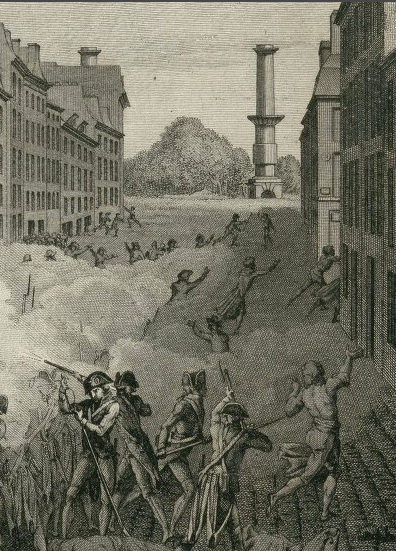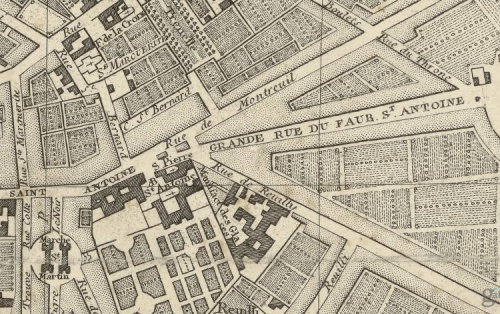needsmoreresearch:Fusillade au fauxbourg St Antoine, le 28 avril 1789. “After the pillag
needsmoreresearch:Fusillade au fauxbourg St Antoine, le 28 avril 1789. “After the pillage of Réveillon’s house and factory, the French and Swiss Guards, advancing on the neighborhood in pursuit of the brigands, were attacked with a hail of stones and tiles thrown down from various houses; they fired upon their assailants, making a great carnage.“ Drawing by Vény and Girardet, engraving by Pélicier, finished by Cl. Niquet. (Also with a 1790 map of Paris by L-J Mondhare, showing the area of the Faubourg St-Antoine in the picture.)On April 23, wallpaper manufacturer Réveillon and powder manufacturer Henriot gave speeches apparently lamenting the days when workers could get by on 15 sous a day. The speeches–and possibly rumors or interpretations that they signaled a coming cut in wages, in a time of terrible unemployment and poverty–set off protests in the Faubourg Saint-Antoine and other neighborhoods. On the 27th several peaceful demonstrations took place, beginning with a gathering near the Bastille; that evening Henriot’s house was attacked and some furniture and personal property destroyed. That crowd was dispersed without loss of life, but further guards and mounted troops were brought into the neighborhood to stand by.On the 28th more workers joined the protests. Among the groups were the 500 employees of the Royal Glass Manufactory (bottom center of the map): the police had instructions to forcibly keep them at their work, but demonstrators broke in the doors and brought the workers to join them. That evening people stormed Réveillon’s house (along the Rue de Montreuil) and ransacked it. The commander of the French Guard gave the order to fire. "In spite of the massacre that followed in the narrow congested streets with thousands crowding the windows and roofs, the crowd stood firm and fought back with shouts of ‘Liberté…nous ne cederons pas!’ Others shouted, ‘Vive le tiers état!’ and even 'Vive le Roi! Vive M. Necker!’" The fighting lasted until 8 o'clock. The number of dead and wounded has never been established. Accounts run from the official (almost certainly incomplete) 22 killed and 25 injured to numbers in the high hundreds. The top picture shows the fighting at the junction of Rue St. Bernard, Rue de Montreuil, and the Rue du Faubourg Saint-Antoine.The men and women arrested in connection with the riot and demonstrations came from Saint-Antoine and some of the nearby neighborhoods. Incidentally, none of Réveillon’s workers were accounted among the killed, wounded, and arrested. (source: mostly from Rudé’s The Crowd in the French Revolution. Leonard N. Rosenband gives another close account in "Jean-Baptiste Réveillon: A Man on the Make in Old Regime France,” French Historical Studies, vol 20, no 3, 1997.) -- source link
Tumblr Blog : needsmoreresearch.tumblr.com
#réveillon#french revolution#pilferingapples



